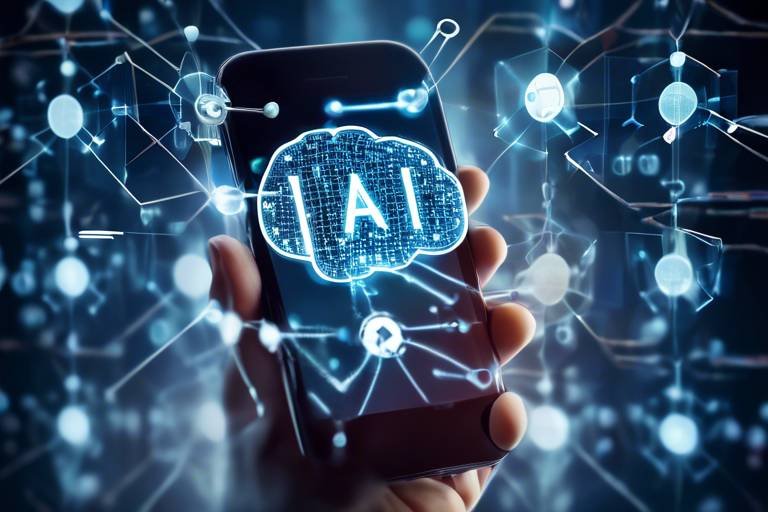How to Leverage AI in Predictive Research
In today's fast-paced world, the ability to anticipate future trends and behaviors is invaluable. Artificial Intelligence (AI) has revolutionized the field of predictive research, allowing organizations to harness the power of data like never before. By utilizing advanced algorithms and machine learning techniques, researchers can uncover insights that were previously hidden within vast amounts of information. But how exactly can we leverage AI in predictive research to make smarter, data-driven decisions? Let’s dive into the transformative impact of AI on this field.
At its core, predictive research is about forecasting future events based on historical data. Think of it as trying to read the tea leaves of data; the more accurate your reading, the better your decisions will be. With the integration of AI, this process becomes not only faster but also significantly more accurate. AI enhances traditional methods by analyzing complex datasets and identifying patterns that human researchers might overlook. Imagine having a supercharged assistant that can sift through mountains of data in seconds, pinpointing trends and anomalies that could inform your strategy. That’s the power of AI in predictive research!
The methodologies employed in AI-driven predictive research are varied and sophisticated. From machine learning algorithms to neural networks, these technologies are designed to improve the precision of predictions. For instance, machine learning algorithms can learn from new data inputs, continuously refining their accuracy over time. This adaptability is crucial in a world where data is constantly evolving. Moreover, AI can automate data analysis, allowing researchers to focus on interpreting results rather than getting bogged down in the nitty-gritty of data processing.
As we explore the role of AI in predictive research, it’s essential to understand the different types of machine learning algorithms available. These can be broadly categorized into supervised and unsupervised learning. Supervised learning uses labeled datasets to train models, making it ideal for tasks where the outcome is known. On the other hand, unsupervised learning analyzes unlabeled data to identify hidden patterns. This distinction is vital for researchers as it influences the choice of algorithm based on the nature of the data and the specific research objectives.
Another exciting aspect of AI in predictive research is the application of neural networks. These complex structures mimic the way the human brain operates, allowing for the analysis of intricate data patterns. They excel in tasks such as image recognition, natural language processing, and, of course, predictive modeling. By leveraging neural networks, researchers can enhance their ability to predict outcomes in diverse fields, from healthcare to finance.
However, all these powerful tools and techniques hinge on one critical element: data collection. High-quality data is the backbone of effective predictive research. Without it, even the most sophisticated AI algorithms will falter. Researchers must employ best practices for data gathering, ensuring that their datasets are comprehensive, accurate, and relevant. Techniques such as surveys, experiments, and observational studies can all contribute to building a robust dataset that will yield meaningful insights.
In conclusion, the integration of AI in predictive research is not just a trend; it's a game-changer. By embracing these technologies, researchers can unlock new levels of accuracy and efficiency in their forecasts. As we continue to explore this exciting frontier, the potential applications of AI in predictive research are boundless, promising a future where data-driven decision-making is the norm rather than the exception.
- What is predictive research? - Predictive research involves forecasting future trends and behaviors based on historical data.
- How does AI enhance predictive research? - AI improves accuracy and efficiency by analyzing complex datasets and uncovering hidden patterns.
- What are the main types of machine learning? - The two main types are supervised learning and unsupervised learning.
- Why is data collection important? - High-quality data is essential for making accurate predictions and ensuring the effectiveness of AI algorithms.

Understanding Predictive Research
Predictive research is like having a crystal ball that allows us to glimpse into the future. By analyzing historical data, researchers can forecast trends and behaviors, making it an invaluable tool across various fields. Imagine being able to predict customer preferences before they even know what they want! This is the power of predictive research, and with the infusion of artificial intelligence (AI), its accuracy and efficiency have skyrocketed.
At its core, predictive research involves collecting data, analyzing it, and applying statistical models to forecast future outcomes. The significance of this process cannot be overstated. Businesses, for instance, can tailor their marketing strategies based on predicted consumer behavior, while healthcare providers can anticipate patient needs and allocate resources more effectively. The integration of AI into this equation enhances the precision of these predictions, allowing researchers to handle larger datasets and uncover hidden patterns that traditional methods might miss.
One of the most compelling aspects of predictive research is its ability to transform raw data into actionable insights. With the help of AI, researchers can utilize sophisticated algorithms that learn from data over time, improving their predictive capabilities. For example, a retailer might analyze past sales data to forecast future inventory needs, thereby reducing waste and maximizing profits. This not only saves money but also optimizes the supply chain, creating a win-win situation for businesses and consumers alike.
Furthermore, the role of AI in predictive research extends beyond mere number crunching. It involves machine learning, which enables systems to learn from data inputs and improve their predictions without human intervention. This self-improving mechanism is akin to teaching a child to ride a bike; the more they practice, the better they become. In the context of predictive research, the more data the AI processes, the more accurate its forecasts become.
In summary, understanding predictive research is essential for anyone looking to leverage data effectively. As businesses and organizations strive to stay ahead of the competition, the integration of AI into predictive methodologies will undoubtedly play a critical role. The future landscape of data-driven decision-making is bright, and those who harness the power of predictive research will be well-equipped to navigate the complexities of tomorrow's challenges.

The Role of AI in Data Analysis
In today's data-driven world, the role of Artificial Intelligence (AI) in data analysis cannot be overstated. AI technologies are revolutionizing how researchers and organizations approach data, transforming raw numbers into actionable insights. Imagine having a super-intelligent assistant that never tires, tirelessly sifting through mountains of data to uncover hidden patterns and trends. That's precisely what AI does, and it does it with remarkable speed and accuracy.
AI systems utilize advanced algorithms to automate and streamline the data analysis process. These systems can handle vast datasets that would overwhelm traditional analytical methods. For instance, while a human analyst might take weeks to process a large dataset, an AI can analyze it in a matter of hours or even minutes. This efficiency not only saves time but also allows researchers to focus on interpreting the results rather than getting bogged down in the data itself.
One of the most significant advantages of AI in data analysis is its ability to identify patterns that humans might miss. Through techniques such as machine learning and deep learning, AI can learn from historical data, improving its predictive capabilities over time. For example, in the realm of predictive research, AI can analyze customer behavior data to forecast future purchasing trends. This capability is invaluable for businesses looking to tailor their marketing strategies effectively.
Moreover, AI tools come equipped with various functionalities that enhance the data analysis process. Some of the most commonly used AI tools include:
- Natural Language Processing (NLP): Helps in analyzing text data from surveys, social media, and customer feedback.
- Predictive Analytics: Utilizes statistical algorithms and machine learning techniques to identify the likelihood of future outcomes based on historical data.
- Data Visualization Tools: AI can create dynamic visual representations of data, making it easier to understand complex information at a glance.
These tools not only enhance the efficiency of data analysis but also empower researchers to make informed decisions based on real-time insights. For instance, a financial analyst can utilize AI-powered predictive analytics to gauge market trends and make investment decisions that are well-informed and data-backed.
Furthermore, the integration of AI into data analysis fosters a culture of data-driven decision-making. Organizations that leverage AI tools can quickly adapt to changing market conditions, ensuring they remain competitive. By analyzing customer feedback and market trends, businesses can pivot their strategies in real-time, leading to increased customer satisfaction and loyalty.
As we look to the future, the role of AI in data analysis is only expected to grow. With advancements in technology, AI will become even more sophisticated, allowing for deeper insights and more accurate predictions. The potential applications are limitless, ranging from predicting disease outbreaks in healthcare to optimizing supply chain management in retail.
In conclusion, AI's role in data analysis is transformative, paving the way for more accurate predictions and data-driven strategies across various industries. As organizations continue to embrace AI technologies, the landscape of data analysis will evolve, making it an exciting field to watch in the coming years.

Machine Learning Algorithms
When it comes to predictive modeling, are the backbone of the process. These algorithms allow researchers to analyze vast amounts of data and uncover hidden patterns that can lead to accurate predictions. Imagine trying to find a needle in a haystack; machine learning acts as a magnet, pulling out the relevant data points that can inform future decisions. In this section, we’ll dive deeper into the different types of algorithms, their functionalities, and how they transform raw data into actionable insights.
At the heart of machine learning are two primary categories of algorithms: supervised learning and unsupervised learning. Supervised learning relies on labeled datasets, where the algorithm learns from input-output pairs. For example, if you were training a model to predict house prices, you would provide it with historical data that includes both the features of the houses (like square footage, number of bedrooms, etc.) and their corresponding prices. The model learns the relationship between these inputs and outputs, allowing it to predict prices for new, unseen houses.
On the other hand, unsupervised learning deals with unlabeled data. Here, the algorithm seeks to identify patterns and groupings without any prior knowledge of the outcomes. Think of it like a detective piecing together clues from a crime scene without knowing what the crime is. Clustering techniques, such as K-means or hierarchical clustering, are often used in this context, helping researchers segment data into meaningful categories.
Another fascinating aspect of machine learning is the use of neural networks. These algorithms are inspired by the structure of the human brain and are particularly effective in handling complex datasets. A neural network consists of layers of interconnected nodes (or neurons) that process information. The more layers a network has, the more complicated the patterns it can learn. This multi-layered approach allows neural networks to excel in tasks like image recognition and natural language processing, making them invaluable tools in predictive research.
| Algorithm Type | Description | Application |
|---|---|---|
| Supervised Learning | Uses labeled data to predict outcomes. | House price prediction, spam detection. |
| Unsupervised Learning | Identifies patterns in unlabeled data. | Customer segmentation, anomaly detection. |
| Neural Networks | Multi-layered structures that model complex patterns. | Image recognition, speech recognition. |
In summary, machine learning algorithms are not just tools; they are the architects of predictive models that shape our understanding of future trends. By leveraging these algorithms, researchers can turn complex data into clear, actionable insights, paving the way for better decision-making across various fields. As we continue to explore the potential of AI in predictive research, one thing is clear: the algorithms we choose will significantly influence the accuracy and effectiveness of our predictions.
- What is the difference between supervised and unsupervised learning? Supervised learning uses labeled data to train models, while unsupervised learning analyzes unlabeled data to find patterns.
- How do neural networks work? Neural networks consist of layers of interconnected nodes that simulate the way the human brain processes information, allowing for complex pattern recognition.
- Can machine learning algorithms predict future events? Yes, machine learning algorithms analyze historical data to identify trends and make predictions about future outcomes.

Supervised vs. Unsupervised Learning
When diving into the world of predictive research, understanding the difference between supervised and unsupervised learning is pivotal. Imagine you're a teacher guiding students through a complex subject; this is akin to supervised learning, where a model learns from labeled data. In this scenario, the data comes with predefined outcomes, allowing the algorithm to make predictions based on historical examples. For instance, if we have a dataset of housing prices along with features like size, location, and number of bedrooms, the model can learn to predict future prices by recognizing patterns in the labeled data.
On the other hand, unsupervised learning is like a student exploring a new subject without any guidance. Here, the model is fed with data that lacks labels, and its goal is to identify patterns or groupings within that data. Think of it as trying to find hidden treasures in a vast ocean of information without any map. For example, clustering algorithms can group similar customers based on purchasing behavior without prior knowledge of their categories. This aspect of unsupervised learning is particularly useful in market segmentation, where businesses can uncover distinct customer profiles.
To illustrate the differences more clearly, let’s break down the key characteristics of both supervised and unsupervised learning in the following table:
| Feature | Supervised Learning | Unsupervised Learning |
|---|---|---|
| Data Type | Labeled Data | Unlabeled Data |
| Goal | Predict outcomes | Discover patterns |
| Common Algorithms | Linear Regression, Decision Trees | K-Means Clustering, Hierarchical Clustering |
| Use Cases | Spam detection, Credit scoring | Customer segmentation, Anomaly detection |
In practice, the choice between supervised and unsupervised learning often depends on the specific problem at hand and the availability of labeled data. For instance, if you're trying to predict whether a loan applicant will default based on historical data, supervised learning is your best bet. However, if you're looking to identify trends in customer behavior without any prior labels, unsupervised learning would be the way to go.
Ultimately, both approaches play a crucial role in enhancing the capabilities of predictive research. By leveraging the strengths of supervised and unsupervised learning, researchers can unlock new insights and drive more informed decision-making across various domains.

Neural Networks in Prediction
Neural networks, a subset of artificial intelligence, have revolutionized the field of predictive research by mimicking the way human brains operate. Think of them as a complex web of interconnected nodes, or neurons, that work together to process information and recognize patterns. This structure allows neural networks to handle vast amounts of data, making them particularly effective for tasks that involve intricate relationships and non-linear correlations. For instance, when tasked with predicting stock prices, a neural network can analyze historical price data alongside various market indicators to forecast future trends.
One of the most exciting aspects of neural networks is their ability to learn from data. Unlike traditional models that rely on predefined rules, neural networks improve their predictive accuracy as they are exposed to more data. This is akin to how we, as humans, learn from experience—trial and error lead us to better decision-making over time. In predictive research, this adaptability is crucial, especially in dynamic environments where patterns can shift rapidly.
Neural networks come in various architectures, each tailored to specific types of data and prediction tasks. For example, Convolutional Neural Networks (CNNs) are particularly effective for image recognition and processing, while Recurrent Neural Networks (RNNs) excel in sequential data analysis, such as time series forecasting. The choice of architecture significantly impacts the model's performance, making it essential for researchers to understand the nuances of each type. Below is a brief overview of different neural network types:
| Type of Neural Network | Best Use Cases |
|---|---|
| Convolutional Neural Networks (CNNs) | Image and video recognition |
| Recurrent Neural Networks (RNNs) | Time series prediction, language modeling |
| Feedforward Neural Networks | General prediction tasks |
| Generative Adversarial Networks (GANs) | Data generation, image synthesis |
Furthermore, the training process of a neural network involves adjusting its weights and biases through a method known as backpropagation. This process minimizes the difference between the predicted output and the actual result, leading to more accurate predictions over time. However, it’s not without challenges; researchers must ensure they have high-quality, representative data to train their models effectively. Poor quality data can lead to inaccurate predictions, which can have serious implications, especially in critical fields like healthcare and finance.
In conclusion, neural networks are a powerful tool in the arsenal of predictive research. Their ability to learn from complex datasets and improve over time makes them indispensable for accurately forecasting future outcomes. As researchers continue to explore and refine these models, the potential applications are virtually limitless, paving the way for smarter, data-driven decision-making across various industries.
- What is a neural network? A neural network is a computational model inspired by the human brain, consisting of interconnected nodes that process data and recognize patterns.
- How do neural networks improve predictions? Neural networks improve predictions by learning from data over time, adjusting their parameters to minimize errors in their forecasts.
- What are the main types of neural networks? The main types include Convolutional Neural Networks (CNNs), Recurrent Neural Networks (RNNs), Feedforward Neural Networks, and Generative Adversarial Networks (GANs).
- Why is data quality important in training neural networks? High-quality data is crucial because poor data can lead to inaccurate predictions, undermining the effectiveness of the model.

Data Collection Techniques
In the realm of predictive research, the foundation of accurate predictions rests heavily on the quality of data collected. Think of data collection as the bedrock of a sturdy building; without it, everything else is destined to crumble. Various techniques are employed to gather high-quality data, each with its unique strengths and weaknesses. Understanding these methods can significantly enhance the effectiveness of predictive models.
One of the most common techniques is surveys. Surveys allow researchers to gather insights directly from individuals, providing valuable qualitative and quantitative data. They can be administered in various formats—online, face-to-face, or via telephone—and can target specific demographics. However, crafting the right questions is crucial. Poorly designed surveys can lead to biased or misleading results. To mitigate this, researchers should ensure questions are clear, concise, and unbiased.
Another effective method is observational research. This technique involves monitoring subjects in their natural environment, allowing researchers to collect data on behaviors and interactions without interference. For instance, in a retail setting, observing customer behavior can yield insights into shopping patterns that surveys might miss. However, it’s essential to consider the ethical implications of observation, ensuring transparency and consent when necessary.
Furthermore, web scraping has emerged as a powerful tool in the digital age. This technique involves extracting data from websites, allowing researchers to gather vast amounts of information across various platforms. For instance, a market analyst might scrape data from e-commerce sites to understand pricing trends. However, it’s crucial to comply with legal guidelines and respect the terms of service of the websites being scraped.
To illustrate the various data collection techniques, here’s a comparative table highlighting their key features:
| Technique | Advantages | Disadvantages |
|---|---|---|
| Surveys | Direct insights, customizable questions | Potential bias, requires careful design |
| Observational Research | Natural behavior, real-time data | Ethical concerns, observer bias |
| Web Scraping | Access to large datasets, quick collection | Legal issues, data accuracy concerns |
In addition to these methods, utilizing existing datasets can also be advantageous. Many organizations and governments publish data that can be leveraged for predictive research. This not only saves time but also enhances the breadth of analysis. However, researchers must evaluate the reliability and relevance of these datasets to ensure their findings are robust.
Ultimately, the choice of data collection technique should align with the research objectives and the specific context of the study. By combining multiple methods, researchers can triangulate their findings, leading to more accurate and reliable predictions. This holistic approach not only enriches the data pool but also strengthens the conclusions drawn from the analysis.
- What is predictive research? Predictive research involves using historical data to forecast future trends and behaviors.
- Why is data collection important in predictive research? The quality of data collected directly impacts the accuracy of predictions made by predictive models.
- What are some common data collection techniques? Common techniques include surveys, observational research, web scraping, and utilizing existing datasets.
- How can researchers ensure data quality? Researchers can ensure data quality by employing well-designed collection methods, triangulating data from multiple sources, and continuously validating their findings.

Applications of AI in Predictive Research
Artificial Intelligence (AI) is revolutionizing the way we approach predictive research across various sectors. Its capacity to analyze vast amounts of data quickly and accurately has led to groundbreaking advancements in numerous fields. Imagine having the ability to foresee trends, behaviors, and potential outcomes with a level of precision that was once the stuff of science fiction. Today, AI is making this a reality, and its applications are as diverse as they are impactful.
In the realm of healthcare, for instance, AI models are being employed to predict patient outcomes and even anticipate disease outbreaks. By analyzing historical patient data, AI can identify patterns that might indicate a rise in certain illnesses, enabling healthcare providers to take proactive measures. For example, during the flu season, AI algorithms can analyze data from previous years to predict where outbreaks are likely to occur, allowing for better resource allocation and preventive strategies.
Moreover, the financial sector is another area where AI's predictive capabilities shine brightly. Financial institutions are leveraging AI to make informed market predictions and conduct risk assessments. By utilizing predictive analytics, they can analyze historical market data, economic indicators, and even social media trends to forecast stock movements and investment opportunities. This not only helps in formulating robust investment strategies but also aids in enhancing financial planning and risk management.
To give you a clearer picture, let’s take a look at some of the specific applications of AI in predictive research across different industries:
| Industry | Application | Impact |
|---|---|---|
| Healthcare | Predicting patient outcomes and disease outbreaks | Improved patient care and resource management |
| Finance | Market predictions and risk assessments | Enhanced investment strategies and financial planning |
| Retail | Customer behavior forecasting | Personalized marketing and inventory management |
| Manufacturing | Predictive maintenance of machinery | Reduced downtime and increased efficiency |
In retail, AI is being utilized to forecast customer behavior, allowing businesses to tailor their marketing strategies effectively. By analyzing purchasing patterns and customer interactions, retailers can predict what products will be in demand, optimizing their inventory and enhancing customer satisfaction. This personalized approach not only drives sales but also fosters customer loyalty.
Additionally, in the manufacturing sector, AI plays a crucial role in predictive maintenance. By monitoring machinery performance and analyzing historical data, AI can predict when a machine is likely to fail or require maintenance. This proactive approach reduces downtime, saves costs, and increases overall efficiency. Think of it as having a crystal ball that tells you when to perform maintenance before a breakdown occurs—now that’s powerful!
As we look to the future, the possibilities of AI in predictive research are boundless. With ongoing advancements in technology and data analytics, we can expect even more innovative applications that will further enhance decision-making processes across industries. The integration of AI into predictive research not only improves accuracy but also empowers organizations to make data-driven decisions that can significantly impact their success.
- What is predictive research? Predictive research involves using historical data to forecast future trends and behaviors.
- How does AI improve predictive research? AI enhances predictive research by analyzing large datasets quickly, uncovering insights and patterns that may not be visible through traditional methods.
- What industries benefit from AI in predictive research? Industries such as healthcare, finance, retail, and manufacturing are significantly benefiting from AI applications in predictive research.

Healthcare Predictions
In the rapidly evolving world of healthcare, the integration of artificial intelligence has revolutionized how we predict patient outcomes and manage disease outbreaks. Imagine walking into a hospital where AI algorithms analyze a patient's history, symptoms, and even genetic data to forecast potential health risks. This isn't science fiction—it's happening now! AI models are increasingly being employed to sift through vast amounts of data, helping healthcare professionals make informed decisions that can save lives.
One of the most significant advantages of using AI in healthcare predictions is its ability to process and analyze data at lightning speed. Traditional methods of data analysis can be tedious and time-consuming, often leading to delays in patient care. On the other hand, AI can quickly identify patterns and correlations that might not be visible to the human eye. For instance, by examining historical patient data, AI can predict the likelihood of a patient developing certain conditions, such as diabetes or heart disease, allowing for early intervention.
Consider the case of predictive analytics in managing chronic diseases. AI algorithms can analyze data from various sources, including electronic health records (EHRs), wearable devices, and even social determinants of health. By doing so, they can identify at-risk populations and tailor preventive measures accordingly. For example, if a community shows a rising trend in obesity rates, AI can help healthcare providers develop targeted intervention programs aimed at promoting healthier lifestyles.
Moreover, AI's role extends beyond individual patient care; it also plays a crucial part in public health surveillance. During outbreaks of infectious diseases, AI can analyze social media trends, search engine queries, and other online activities to predict where outbreaks may occur next. This proactive approach enables healthcare authorities to allocate resources more effectively and implement measures to contain the spread of diseases.
To illustrate the impact of AI in healthcare predictions, consider the following table that summarizes key applications:
| Application | Description | Benefits |
|---|---|---|
| Patient Outcome Prediction | Forecasting potential health risks based on historical data. | Early intervention and personalized treatment plans. |
| Disease Outbreak Management | Analyzing data to predict and manage infectious disease outbreaks. | Improved resource allocation and public health response. |
| Chronic Disease Management | Identifying at-risk populations for chronic diseases. | Tailored preventive measures and intervention programs. |
As we look to the future, the potential for AI in healthcare predictions is boundless. With advancements in machine learning and data analytics, we can expect even more sophisticated models that will enhance our understanding of health trends and patient needs. The question is not whether AI will play a role in healthcare, but rather how we can harness its power to create a healthier world for everyone. The collaboration between technology and healthcare professionals is essential to ensure that these predictions are accurate and actionable, ultimately leading to better patient outcomes.
- What is predictive analytics in healthcare? Predictive analytics in healthcare involves using historical data and AI algorithms to forecast future health outcomes, enabling proactive patient care.
- How does AI improve patient care? AI improves patient care by analyzing large datasets quickly, identifying potential health risks, and allowing for early intervention.
- Can AI predict disease outbreaks? Yes, AI can analyze various data sources to predict disease outbreaks and help healthcare authorities respond more effectively.

Financial Forecasting
In the world of finance, where every second counts and decisions can lead to significant gains or losses, has become a cornerstone of strategic planning. With the advent of artificial intelligence, the landscape of financial forecasting has dramatically transformed, allowing institutions to harness the power of data like never before. Imagine having a crystal ball that not only predicts market movements but also adapts to new information in real-time. That's precisely what AI brings to the table.
AI technologies, particularly predictive analytics, enable financial institutions to analyze vast amounts of historical data swiftly and accurately. By employing machine learning algorithms, these institutions can identify trends and patterns that would be nearly impossible for humans to discern. For instance, algorithms can sift through years of stock prices, economic indicators, and even social media sentiments to forecast future market behaviors. This capability not only enhances the precision of predictions but also allows for proactive decision-making.
One of the most significant applications of AI in financial forecasting is in risk assessment. Financial institutions can now evaluate the potential risks of investments with unprecedented accuracy. By using AI models, they can simulate various market scenarios and assess their impacts on investment portfolios. This simulation process helps in understanding the volatility of assets and assists in formulating strategies to mitigate risks. For example, banks can utilize AI to predict the likelihood of loan defaults based on a borrower's financial history and current market conditions.
Moreover, AI-driven financial forecasting is not limited to just predicting stock prices or assessing risks. It extends to optimizing investment strategies. By analyzing market trends and consumer behavior, AI can recommend the best times to buy or sell assets. This capability is akin to having a seasoned financial advisor at your fingertips, constantly analyzing data and providing insights that can lead to lucrative investment opportunities.
To illustrate the impact of AI in financial forecasting, let’s look at a simple comparison table:
| Traditional Methods | AI-Driven Forecasting |
|---|---|
| Relies heavily on historical data analysis | Incorporates real-time data and trends |
| Time-consuming manual analysis | Automated, rapid data processing |
| Limited predictive accuracy | Higher accuracy through machine learning |
| Static models | Dynamic models that adapt to new data |
In conclusion, the integration of AI in financial forecasting has revolutionized how financial institutions operate. By providing enhanced accuracy, efficiency, and adaptability, AI not only helps in predicting market movements but also empowers organizations to make informed decisions that can lead to significant competitive advantages. As we move forward, the role of AI in finance is set to expand even further, paving the way for smarter, data-driven decision-making processes.
- What is financial forecasting? Financial forecasting is the process of estimating future financial outcomes based on historical data and market analysis.
- How does AI improve financial forecasting? AI improves financial forecasting by analyzing large datasets quickly, identifying patterns, and providing more accurate predictions.
- What are some applications of AI in finance? AI is used in risk assessment, investment strategy optimization, fraud detection, and customer service enhancements.
- Can AI completely replace human analysts? While AI can significantly enhance forecasting accuracy, human analysts are still essential for interpreting data and making strategic decisions.
Frequently Asked Questions
- What is predictive research?
Predictive research is a method that focuses on forecasting future trends and behaviors by analyzing historical data. It's like trying to predict the weather based on past patterns; you look at what has happened before to make educated guesses about what might happen next.
- How does AI enhance predictive research?
AI enhances predictive research by streamlining data analysis processes, allowing researchers to uncover patterns and insights more efficiently. Think of AI as a supercharged assistant that can sift through mountains of data in seconds, helping you find the nuggets of information that matter most.
- What are machine learning algorithms?
Machine learning algorithms are computational methods that enable systems to learn from data and improve over time without being explicitly programmed. They’re like teaching a child how to ride a bike; the more they practice, the better they get at balancing and pedaling.
- What is the difference between supervised and unsupervised learning?
Supervised learning involves training a model on labeled data, where the outcome is known, while unsupervised learning deals with unlabeled data, where the model tries to find patterns on its own. It's the difference between having a teacher guiding you through a math problem and figuring it out all by yourself.
- How are neural networks used in predictive research?
Neural networks are designed to mimic the way the human brain processes information, making them particularly effective for handling complex data patterns. They can identify relationships in data that might be too intricate for traditional methods, much like how we recognize faces in a crowd.
- What are some data collection techniques for predictive research?
Effective data collection techniques include surveys, interviews, and automated data scraping from online sources. It’s crucial to gather high-quality data, as the accuracy of predictions largely depends on the quality of the data fed into the system.
- How is AI applied in healthcare predictions?
In healthcare, AI models predict patient outcomes and disease outbreaks by analyzing vast amounts of medical data. For instance, they can forecast the spread of a virus by examining patterns in patient data and historical outbreaks, helping healthcare providers prepare and respond effectively.
- What role does AI play in financial forecasting?
Financial institutions use AI for market predictions and risk assessment, allowing them to make informed investment decisions. By analyzing trends and patterns in financial data, AI helps businesses navigate the complex world of finance with greater confidence.



















